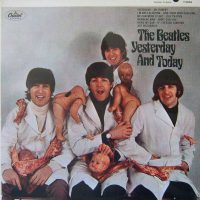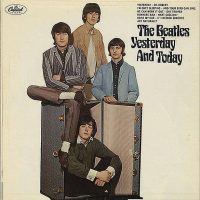The release
Capitol printed the cover for Yesterday… And Today in early June 1966, ahead of its release on the 15th.
EMI had submitted photographs from the Whitaker session, based on The Beatles’ wishes. John Lennon and Paul McCartney later claimed that the cover photograph was a statement against the Vietnam War.
Capitol’s president Alan Livingston initially objected to using the image, but Brian Epstein informed him that The Beatles were resolute that it be the cover. In a 2002 interview with Mojo magazine, Livingston claimed that McCartney had been the most insistent.
We took the pictures in London at one of those photo sessions. By then we were really beginning to hate it – a photo session was a big ordeal, and you had to try and look normal and you didn’t feel it. The photographer was a bit of a surrealist and he brought along all these babies and pieces of meat and doctors’ coats, so we really got into it, and that’s how we felt – ‘Yeah!’I don’t like being locked in to one game all the time, and there we were supposed to be sort of angels. I wanted to show that we were aware of life, and I really was pushing for that album cover. I would say I was a lot of the force behind it going out and trying to keep it out.
I especially pushed for it to be an album cover, just to break the image. And it got out in America: they printed it and about 60,000 got out, and then there was some kind of fuss, as usual, and they were all sent back in or withdrawn, and they stuck that awful-go-lucky foursome. We tried to do something different. We would design a cover or have control of more of our own covers in England, but America always had more albums so they always needed another picture, another cover. We used to say, ‘Why can’t we put fourteen [tracks] out in America?’ Because we would sequence the albums – how we thought they should sound – and we put a lot of work into the sequencing too. They wouldn’t let us put fourteen out; they said there was some rule or something. And so we almost didn’t care what happened to the albums in America until we started coming over more, and noticing [for instance that] on the eight tracks they’d have out-takes and mumbling on the beginning – which is interesting now, but it used to drive us crackers. We’d make an album and they’d keep two from two from every album.
Anthology
The label prepared around 750,000 copies of Yesterday… And Today with the butcher cover, with approximately 60,000 being sent to press and US radio stations for promotional purposes. The sleeves were prepared at Capitol’s four US plants in Los Angeles, California; Scranton, Pennsylvania; Winchester, Virginia; and Jacksonville, Illinois. There were around ten times as many mono copies made than stereo.
The pushback was immediate, with the majority of retailers point-blank refusing to stock the album. Livingston contacted Epstein, who acceded to Capitol’s demands to issue a replacement. On 10 June the label began Operation Retrieve, in which all copies were recalled from distributors, as were promotional items such as posters and advertisements. The total cost of the replacement was estimated at $250,000. Despite these efforts, a small number of copies were sold to fans on 15 June.
On 14 June, Capitol sent a press release to reviewers requesting that they ignore the artwork. It quoted Livingston as saying: “The original cover, created in England, was intended as ‘pop art’ satire. However, a sampling of public opinion in the United States indicates that the cover design is subject to misinterpretation.”
The butcher backlash was reported in Billboard on 25 June 1966. It was The Beatles’ first major controversy, and came just one month before the publication in Datebook of John Lennon’s “We’re more popular than Jesus” remarks.
Capitol issued letters of apology and hastily re-released the album with a replacement cover, also taken by Whitaker. The new image was an unremarkable image of Paul McCartney sitting inside a trunk, surrounded by the other Beatles.
On 8 July 1966 the Recording Industry Association of America certified Yesterday… And Today as a gold record for sales of over a million. It topped the Billboard Top LPs chart in the US on 30 July, remaining at number one for five weeks. It also topped the Cash Box and Record World charts.
Yesterday… And Today was also sold as an import in the UK by EMI International.
By the end of 1966, the album had sold 967,410 copies in the US, and 1,230,558 copies by the end of the 1960s.
Yesterday… And Today was first issued on compact disc in 2014, as a standalone release and as part of the box set The US Albums. The artwork came with an additional sticker of the trunk cover.
First, second and third state
Capitol initially told its pressing plant managers to destroy the Yesterday… And Today covers. The majority of those printed at their Jacksonville plant were sent to landfill.
However, the label eventually decided that it would be cheaper to paste the new cover shot over the withdrawn butcher sleeves. The new ‘slick’ was trimmed by around 3mm to allow it to be placed over the offending image.
As word got out that the rare Beatles album was still being sold, albeit with a new image pasted over the top, some fans and collectors tried – mostly unsuccessfully – to peel the cover and reveal the image underneath.
The ‘butcher’ sleeve was Bob Whitaker’s idea. He was trying to get across some sort of earthy idea. It was on the American album – Capitol Records issued different versions from the English ones then – and the retailers were horrified. I’m not sure how many copies they pressed, but the reaction to it was: ‘What it this?’Capitol pasted a new cover over the original sleeves they had already pressed, and then the next pressings had only the new image. But people who bought one of the first batch steamed off the new cover to reveal the ‘butcher’ picture. There are not that many of them out there.
The rarest unpeeled original pressings are known as ‘first state’ covers, and command the highest prices – particularly the rarer stereo pressings. The first documented sale was of a mono copy in 1974, which fetched $457. The value has steadily risen since, and in 2006 a copy sold for $20,000.
Copies with the pasted ‘trunk’ image are known as ‘second state’ or ‘pasteover’ covers. The simplest way to spot these is by looking for the black triangle of Ringo Starr’s t-shirt, visible on the right-hand side underneath the word “Today”.
‘Third state’ covers are those where the trunk image has been removed. These are the most common and least valuable, partly due to the variable quality of the sleeve.
In 1987, Capitol’s former president Alan Livingston put on sale 24 ‘first state’ butcher covers from his collection. In June 1966 Livingston had taken a case of sealed albums from the warehouse before they were had the trunk image pasted over, and kept them in a closet in his home.
Livingston’s son put the pristine albums on sale at a Beatlefest convention in Los Angeles. Now known as ‘Livingston Butchers’, the copies now command premium prices among collectors. One mono edition sold in April 2006 for nearly $39,000.




Can’t really find any real information about my personal copy. Is anyone able to tell me about it?
Details:
Mono copy, Trunk cover (100% sure.) Scranton pressing, rainbow label. My copy lacks an RIAA number. Matrix runouts are:
Side 1: T1-2553-G6#4
Side 2: T2-2553-G2#3
Discogs listing for an RIAA-numberless mono Scranton copy lacks any pricing details, and the only listed runout matrix numbers are T1-2553-G2/T2-2553-G4#2. The only match for the matrix number was a listing for a 3rd-state peeled butcher and those have the RIAA designation 6.
(Sorry if this all looks like a load of nonsense. It’s a little hard to describe something when you can’t find any information on your particular copy. There’s just so many Capitol variants, it hurts the head.)